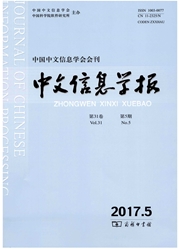

 中文摘要:
中文摘要:
该文基于山西大学自主开发的中文阅读理解语料库CRCC v1.1版,根据问句和候选答案句的对应关系,构建了词层面以及句法层面共计35个特征,基于最大熵模型对中文阅读理解问题回答进行了建模,在35个特征全部加入最大熵模型的情况下,测试集上得到了75.46%的HumSent准确率。考虑到特征取值之间的相关性对权重估计的影响,笔者先对35个特征观测值矩阵进行主成分降维,选择适当的主成分个数重构特征,然后再使用最大熵模型进行建模,在测试集上的HumSent准确率达到80.18%.实验结果表明,在阅读理解问答系统中,采用特征的主成分降维方法,能有效融合全部特征信息,回避了最大熵模型中特征筛选的过程,并且提高了阅读理解系统的准确率。
 英文摘要:
英文摘要:
Based on the CRCC v1. 1 (Chinese reading comprehension corpus) built by Shanxi University, we establish a model of question answering method for Chinese reading comprehension by the maximum entropy (ME) model. Altogether 35 features are suggested on the word level and syntax level according to relationship between question sentence and candidate answer sentences, which result a 75. 46% HumSent accuracy for ME modeling To overcome the dependency among these features which may influence the estimation of parameter weight, we adopt the principal components analysis (PCA) method for all above 35 features, which achieves 80. 18% HumSent accuracy for ME modeling on the testing set. The experimental results show that the PCA method is valid for the feature selection in ME model and enhances the accuracy of the automatic reading comprehension (RC) system.
 同期刊论文项目
同期刊论文项目
 同项目期刊论文
同项目期刊论文
 期刊信息
期刊信息
